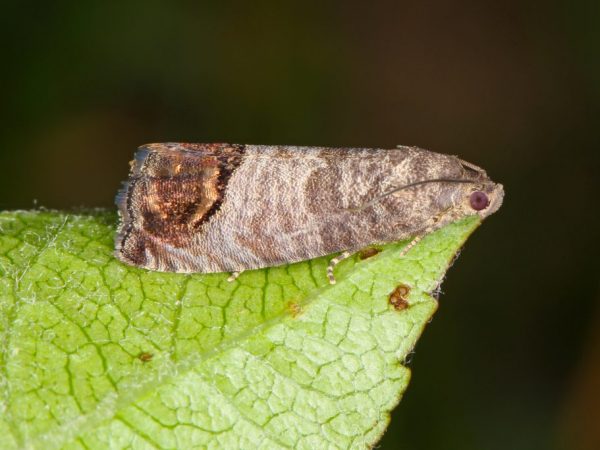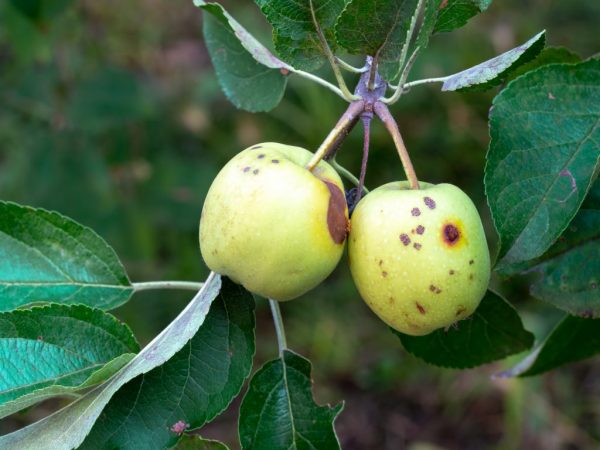Ways to deal with apple moth
The apple moth (or apple moth) is a small insect from the family of lepidoptera moles. This is a dangerous pest of the apple tree. Distributed in European countries, including the Siberian part of Russia.

Ways to deal with apple moth
Biological description of varieties
Common types:
- The leafworm, or apple moth, is a small white-silver moth, a wingspan of no more than 2 cm. Caterpillars 1.2-1.3 mm long, painted yellow-green with shiny specks, the head is light brown.
- Silver speckled - wingspan up to 1.2-1.3 cm. On the wings there are silvery specks and a long silvery fringe. Caterpillars up to 0.5 cm long, green color.
- The miner apple moth - its wingspan is no more than 0.8-0.9 cm. There is a silvery fringe on the narrow wings. Caterpillars are yellow-green, very small. It got its name because of its ability to lay winding passages - "mines" in the gnawed foliage.
- Pocket miner - wingspan up to 1.2 cm. Front wings are narrow, covered with light shading. The caterpillars are colored yellow-green. I form mines about 1.0 cm long and up to 0.5 cm wide.
- The apple baby is a miniature variety, the span of thin wings is up to 0.5 cm. Caterpillars are yellow-white flat.
- The hawthorn circle is a small butterfly with narrow wings covered with a long fringe. Forms mines in the form of dark rounded fragments of small diameter
- Rowanberry is a small butterfly, the wingspan reaches 1-1.3 cm. The front wings are chestnut with silvery spots.
- The apple stoat moth is very small, the wingspan is up to 2.5 cm, the front wings are covered with black dots, and the rear ones are painted in silver. Caterpillars are yellow-white or dark gray, up to 1.7-1.8 cm long.
What is the danger
The pest insect has an increased degree of gluttony and intensive reproduction; in one fruit and berry season, it can damage an entire apple garden.
It eats all vegetative parts of trees: leaves, tree bark, inflorescences and apples.
A pest at the stage of a caterpillar poses a danger to the garden, which, when released from the shield-cocoon, begins to actively mine the foliage, forming a sheath of cobwebs around it. Affected foliage will acquire a brown tint, dry out and fall off.
The insect is able to absorb the green mass of trees for 1.5 months, then pupates in the nest, laying the future offspring. The butterflies that appeared after 14 days lay their eggs. As a result of the full development cycle of the pest, photosynthesis is completely disrupted in trees. Apple trees lose their resistance to cold temperatures and become vulnerable to frost in winter.
By the last days of May, the caterpillars reach the upper part of the tree crown and build wide nests there, capturing new leaves. The number of tracks in one nest reaches 1000.
As a result of the massive attack, the trees stop bearing fruit. Harvests from previously damaged apple trees are harvested only after 2 years have passed since the removal of the pest.
Moth control
They begin to fight moths on apple trees from the end of April, while caterpillars weakened after wintering are still susceptible to toxic chemicals and have not caused significant damage to trees.
Garden processing scheme:
- initially, the garden culture is carefully examined for the presence of moths, determining the nature of the pest attack;
- when mass accumulations are detected, they make a choice in favor of insecticidal agents; in isolated cases, they treat the garden culture with biological products;
- processing is carried out not selectively, but everywhere, because the pest is able to migrate to untreated trees;
- for the destruction of eggs, spraying of apple trees is carried out at least 2 times per fruit and berry season, while making a choice in favor of preparations containing paraffin in the composition.

Insects can seriously harm the tree
Immediately after the treatment, the trees are fertilized by introducing fertilizing complexes at the root. Suitable fertilizers:
- ready-made mineral compositions;
- urea, 1.5 tbsp. which is diluted in 10 liters of water. The working fluid is initially sprayed along the projection of the crown, and then the soil is watered at the root;
- nitroammofosk, it is bred in a proportion of 1 tbsp. per 10 liters of water, applied under the root for trees up to 5 years old, 2-3 liters each, over 5 years old - 5-6 liters each.
Treatment with biological complexes
The advantage of biological products is a gentle effect on trees and humans and the absence of restrictions on the amount of use.
However, the effectiveness of these compositions is much less, the caterpillars die only a week after treatment, therefore biological complexes are not used in case of massive damage to the garden culture, when emergency measures are required.
Suitable for the fight against apple moth:
- Entobacterin - 100 grams per 10 liters of water;
- Lepidocide - 20 grams per 10 liters of water;
- Bitoxibacillin - 70 grams per 10 liters of water.
Spraying of a garden culture with biological complexes is carried out at an ambient temperature of 15'C and above.
Chemical treatment
You can fight moths on apple trees with the help of insecticidal drugs: Actellik, IntaVir, Phosphamide and the like.
In case of massive damage to trees, they resort to the insecticide Fozalon, which contains organochlorine compounds that have a quick destructive effect on 70% of the caterpillars.
When a pest spreads over a wide area, treatment with chemical preparations is not an effective way of fighting - they quickly become addicted to the active components, so the preparations must be alternated.
For the destruction of adults, one treatment with an insecticidal agent is enough. You can completely get rid of the caterpillars only after 5-6 treatments with chemical compounds.
Folk remedies against moths

To combat moths, you can use folk remedies.
Many gardeners choose to deal with moths with folk measures.
Bitter pepper
Bitter peppers in pods are crushed and poured into 1 liter of water, boiled for 1 hour and kept for a day. Add 40 grams of laundry soap to the strained infusion for spraying.
Tobacco
Tobacco infusion is prepared from 800 g of tobacco and 10 liters of water, keeping for a day.
Mechanical methods
In addition to treatments with biologicals, chemical and folk remedies, they use mechanical measures to combat apple moth:
- by hand in the spring, brown young foliage is collected, in which the caterpillars have settled;
- using a jet of water under high pressure, the caterpillars are washed off the foliage;
- at the flowering stage and after it ends, caterpillar cocoons are collected by hand or by means of poles with forks at the ends.
To destroy the pest, they use the attraction to the garden plot of natural enemies of insects - birds, by hanging feeders on the apple trees.The tahina fly and the braconid wasp, which parasitize on caterpillars, are also natural enemies of the moth.
Additionally, traps are hung up:
- pheromones attract males, preventing them from fertilizing females;
- with UV radiation, they lure insects into the light, which, when they come into contact with an energized grid, die from a coronary discharge.
Conclusion
Especially voracious apple moth destroys all vegetative parts of plants. Without taking timely measures, it can damage the entire garden culture during the season.
Pest control measures include pruning branches, thinning the apple crown and burning all plant debris.
The garden is treated with biological products and chemicals, folk methods are actively used.

